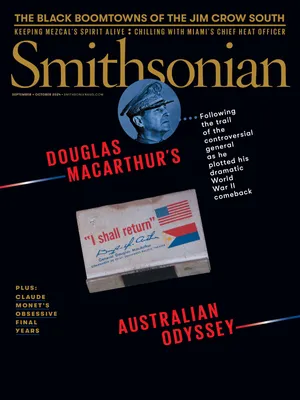At a Bold Meeting 250 Years Ago, the Continental Congress Set America in Motion
While far less famous than the coalition that met in 1775, this group of founders found agreement in their disagreements and laid the groundwork for a revolution
:focal(3360x2240:3361x2241)/https://tf-cmsv2-smithsonianmag-media.s3.amazonaws.com/filer_public/6e/9a/6e9aa339-c80d-423f-931f-abd39060ce2c/20240731_general_macarthur_0074.jpg)
“I feel myself unequal to this business” confessed John Adams, of the “grand scene open before me—a Congress.” In the fall of 1774, Adams and 55 other delegates journeyed all manner of distances by foot, horseback and carriage to Philadelphia for the First Continental Congress. Before now, few of “the wisest men upon the continent,” as Adams described the delegates in his diary, had ever left their colonies or collaborated with one another, but there was power in numbers—or, at least, they had seen there was weakness without them.
In March 1774, British Parliament punished the Massachusetts colony for the Boston Tea Party with the Coercive Acts, which closed the Port of Boston, reduced Massachusetts’ powers of self-government, provided for quartering troops in the Colonies and permitted royal officers accused of crimes to be tried in England. In so doing, these measures stirred sympathy for Massachusetts, and the other colonies sent aid, including desperately needed food, and planned, for the first time, to consider a coordinated response, at great risk to all. Indeed, though Georgia had sent aid to Boston, the Southern colony sent no delegates to Philadelphia, fearing Parliament would retaliate by withholding military aid amid Georgia’s conflict with several Indian tribes.
From the start, the Virginia delegation was remarkably dominant: George Washington, the future general of the yet-to-be-formed Continental Army, arrived with Patrick Henry, while Peyton Randolph, a Virginian agricultural magnate, was elected president of the Congress on the first day.
/https://tf-cmsv2-smithsonianmag-media.s3.amazonaws.com/filer_public/40/1b/401bac0d-747c-4a2e-af71-7d5e6bf4676b/sepoct2024_l04_prologue.jpg)
Though leaders sought to transcend inter-colonial rivalries—“I am not a Virginian, but an American,” Henry dramatically announced on September 6, 1774, in Carpenters’ Hall—unity was an immediate challenge. The delegates agreed on certain measures, like a boycott of British goods, but they disagreed about larger goals, in particular whether they should advocate for an entirely new system of government in the Colonies.
Before the Congress, each colony had its own money and tender laws; most goods produced here were sent direct to London, where merchants would determine a price—and colonists then, in turn, had to purchase goods from London. This captive market exempted the mother country from competing with its European neighbors. By the time the delegates left Philadelphia, on October 26, 1774, they had a decisive plan that would create the first shared economy among the Colonies. If George III did not grant their redress by December, they would boycott British goods. Washington loved luxurious textiles from abroad but took solace in knowing the British would soon stop receiving coveted colonial exports like lumber and dried fish.
The delegates did not speak of more extreme action, but they did, in their own ways, plan for it. As a group, the delegates committed to a second meeting in the spring. And Washington, who hadn’t led an army since he resigned from the British militia in his late 20s, made some telling purchases before returning to Mount Vernon, his Virginia plantation: muskets, military garb and a book on military discipline.
But there was still the matter of dear King George. Most delegates, like most colonists in America, believed the king loved them. Though far off, he was omnipresent in portraits, pamphlets and holidays celebrating his birth.
On October 25, the last day of the Congress, the king’s “loyal and happy subjects” in the Colonies made an earnest attempt to “lay our grievances before the throne” in the form of a petition requesting, among other things, a repeal of the Intolerable Acts, to be delivered by Benjamin Franklin. While the petition was unsparing in its denunciation of Parliament, it was replete with testaments of the colonists’ fealty to the king’s “royal authority over us, and our connection with Great Britain.”
/https://tf-cmsv2-smithsonianmag-media.s3.amazonaws.com/filer_public/27/c1/27c13d8f-7df2-42cf-944e-0b81d835887c/sepoct2024_l20_prologue.jpg)
All hope of royal intervention and Parliamentary redress was soon dashed. The petition reached George by the end of the year, but he refused to read it—a betrayal that shattered the colonists’ vision of their king and, soon enough, their ties to the empire. Perhaps ironically, the colonists’ widespread love for the man they sometimes called “our common father” had led them to engage in magical thinking: that the king would break with law and custom by overruling Parliament. In fact George’s only constitutional choice was to defer to Parliament on the colonists’ petition, which is precisely what he did—and Parliament pointedly ignored it. Today, he’s remembered as the man who lost America. Really, Parliament deserves that honor.
The king’s reputation sank swiftly following his refusal to read the petition. The following April, in 1775, many delegates learned of the Battles of Lexington and Concord while en route to Philadelphia for the Second Continental Congress, where war was declared, and where Washington was appointed commander of the Continental Army. Thomas Jefferson, a new delegate from Virginia, was the principal author of the Declaration of Independence. In it, George is memorialized as a “tyrant” who is “unfit to be the ruler of a free people.” No matter that royal emblems remained on public buildings throughout the war.
The First Continental Congress is sometimes forgotten, given the enormous consequence of the Second. But this fall, its 250th anniversary offers Americans important lessons about how the U.S. took its first steps into existence—and how different those steps were from what we might imagine. A frisson of royalism has remained with us, always, from the widespread obsession with the fairytale of John F. Kennedy’s Camelot, to just about any marriage, coronation, funeral or scandal out of Buckingham Palace. In this, at least, we are the true heirs to our colonial forebears. The majority of British subjects in North America did not pine for liberty, or exhibit a general disdain for royal pomp, or loathe the monarchy, until the very last minute—if at all.
